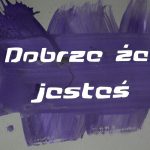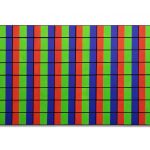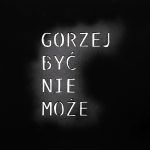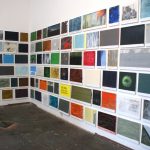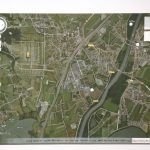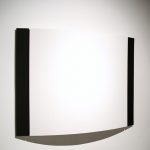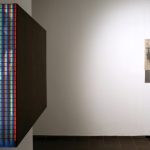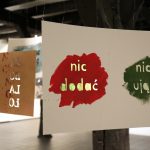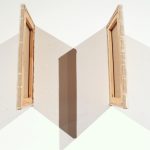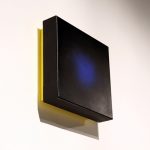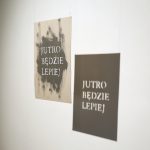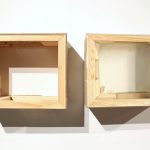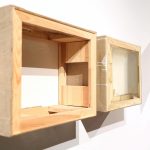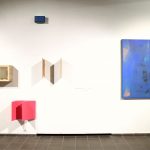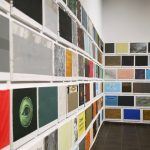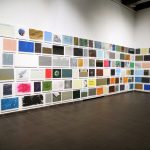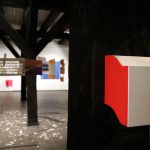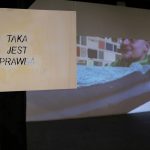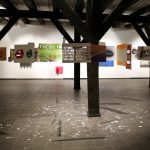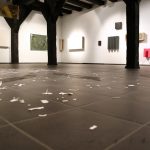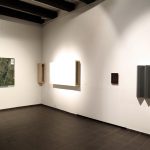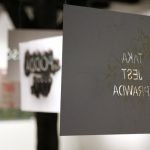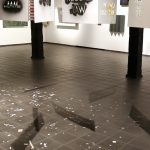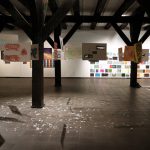Maciej Andrzejczak & Dawid Marszewski: „Półśrodki”Maciej Andrzejczak & Dawid Marszewski: “Half Measures”
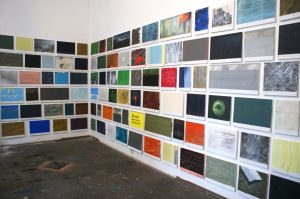
Maciej Andrzejczak & Dawid Marszewski: „Półśrodki”
kuratorka: Marta Smolińska
otwarcie wystawy: 01.03.2019 (piątek), godz. 18.00 / wstęp wolny
wystawa czynna do 28.04.2019 / przedłużona do 05.05.2019!
Świat sztuki bywa przewrotny. Paradoksalnie czasem nie środki, a półśrodki prowadzą do bardziej inspirujących rozwiązań. Zatrzymanie się w pół kroku, pozostanie przy wstępnym modelu, zdanie się na szablon, inspirowanie się obrazami wirtualnymi o niskiej rozdzielczości, korzystanie z czegoś, co już gotowe lub półgotowe – to tylko kilka strategii wdrażania półśrodków, stosowanych przez Macieja Andrzejczaka i Dawida Marszewskiego. Twórcy ci intensywnie kręcą się wokół malarstwa. Poruszają się w orbicie sztuki postmedialnej, postkonceptualnej i postinternetowej oraz w aurze nowego materializmu. Przekonują, że coś, co tymczasowe, niedopełnione, prowizoryczne, niedorobione, zrobione z półproduktu… może być kompletne w takim właśnie stanie.
Marszewski, w serii bazującej na szablonach oraz operującej krążącymi we współczesnym języku polskim stwierdzeniami i utartymi zwrotami, czerpie z półśrodków podwójnie. Po pierwsze działa szablonowo – w sensie dosłownym i w przenośni – nie siląc się przy tym specjalnie na oryginalny, zindywidualizowany gest. Po drugie, sięga również po gotowe sformułowania, językowe matryce, które odcisnęły się w potocznej rzeczywistości i bywają powtarzane niczym mantry. Ponadto inspiruje się obrazami wirtualnymi, z niską rozdzielczością, pozwalającymi na siebie długo czekać w trakcie powolnego ładowania się stron internetowych. Powoli, stopniowo ładują się obrazy z wojny w Syrii, masakry na wyspie Utoya, wszelkiej maści katastrof, zamachów oraz politycznej ikonosfery współczesności. Marszewski nie tworzy własnych wyobrażeń o tych wydarzeniach, lecz przygląda się wirtualnym gotowcom, które spływają z ociąganiem się na monitor laptopa. Są – być może – swego rodzaju półśrodkami zarówno w kontekście malarstwa, jak i postrzegania świata.
Również i dla Andrzejczaka półśrodkiem w procesie twórczym są wirtualne, mechanicznie powstające obrazy – w tym wypadku generowane przez skalę kolorów na monitorach. Andrzejczak jako malarz postmedialny i postinternetowy nie napina się na poszukiwanie nowych środków malarskich, lecz ze swobodą czerpie z tych, które – niczym półśrodki – unoszą się w powietrzu współczesności oraz w przebogatych zasobach artystycznej tradycji. Interesuje go ekranowy wymiar obrazu sztalugowego, jak również echo jego obiektowości, tak wyraźne w procesie tworzenia cieni. Artysta zderza także iluzję z ostentacyjnie rozmalowanymi śladami malarskiego gestu czy motywem ociekającej farby. Ponadto gra środkami z zakresu rzemiosła introligatorskiego, kreując wrażenie materialności swoich prac nie tylko na bazie ich uderzającej trójwymiarowości, lecz również w relacji do dialogów z pieczołowicie pokrytymi płótnem okładkami oprawionych ksiąg i dokumentów. Konfrontuje tym samym wirtualne z rzemieślniczym, internetowe z realnie dotykalnym.
Dzięki filmowi „Półśrodki”, nakręconemu przez Andrzejczaka i Marszewskiego w Piekariacie – wspólnej pracowni – wracamy do pytania o znaczenie tytułowej metafory. Krótko przed finalizacją wystawy obaj artyści „podglądają się” wzajemnie w przestrzeni wspólnej pracowni i wciąż nie są pewni, jak rozumieć kłopotliwą metaforę. Poszukują, komentują, żartują, ironizują. Dają odpowiedź jako półśrodek: formę nieco rozmemłanej dyskusji czy niezobowiązujących rozmów w trakcie przygotowywania się do dialogu w Wozowni. Jako odbiorcy jesteśmy tam z nimi. Podpatrujemy na przykład proces gruntowania płótna – czy gotowy grunt to półśrodek? Przyglądamy się atmosferze panującej w pracowni i wsłuchujemy w charakter przyjacielskiej, swobodnej relacji między obydwoma artystami. Ten film to półśrodek do pokazania, czym jest wspólne przebywanie i tworzenie w Piekariacie.
Maciej Andrzejczak – absolwent Uniwersytetu Artystycznego w Poznaniu. W 2017 roku obronił pracę dyplomową „Deziluzja” (praca praktyczna) oraz „Paradoksy i potencjał iluzji w malarstwie” (praca teoretyczna) na Wydziale Malarstwa i Rysunku, w pracowni prof. Andrzeja Zdanowicza. Laureat 37. edycji nagrody im. Marii Dokowicz na najlepszy dyplom Uniwersytetu Artystycznego w Poznaniu (2017). Zdobywca pierwszej nagrody konkursu artNOBLE 2017. Stypendysta Ministra Kultury i Dziedzictwa Narodowego oraz Rektora UAP. Brał udział w wystawach zbiorowych w kraju i za granicą. Doktorant na Wydziale Malarstwa i Rysunku. Od 2018 roku pełni obowiązki asystenta w II Pracowni Rysunku na Uniwersytecie Artystycznym w Poznaniu.
Dawid Marszewski – absolwent Uniwersytetu Artystycznego w Poznaniu. W 2016 roku z wyróżnieniem obronił pracę dyplomową w pracowni prof. Janusza Marciniaka. Od tego samego roku pracuje jako asystent w XII Pracowni Malarstwa. Doktorant na Wydziale Malarstwa i Rysunku. Brał udział w V Biennale Sztuki Współczesnej w Odessie na Ukrainie czy XI Biennale Sztuki Współczesnej w Dreźnie oraz w wielu wystawach w kraju i za granicą, m.in. w Muzeum Współczesnym we Wrocławiu, Centrum Sztuki Współczesnej „Znaki Czasu” w Toruniu czy, ostatnio, w galerii Piteyna w Brnie i Galerii R20 w Poznaniu. Swoje prace prezentował także na kilku wystawach indywidualnych. Jest laureatem nagród za działalność artystyczną, m.in. Medal Młodej Sztuki przyznawany przez „Głos Wielkopolski”. Mieszka i pracuje w Poznaniu.
Maciej Andrzejczak & Dawid Marszewski: „Half Measures”
curated by: Marta Smolińska
exhibition opening: 01.03.2019 (Friday), 6 PM / admission free
exhibition open till 28.04.2019
Sometimes, exhibition titles are born in the course of casual conversations of artists in their studios. This was the case here: I visited Maciej Andrzejczak and Dawid Marszewski in Piekariat (Piekary Street in Poznań), which they share with Anna Róża Kołacka and Kinga Popiela. As an art curator and a historian, I like visiting studios, watching work in progress and discussing it in outside the academia while getting stained with fresh paint.
In the lower room of the Wozownia Art Gallery in Toruń, I imagined the dialogue of the paintings by Andrzejczak and Marszewski, as happening outside the atmosphere and space of Piekariat. Hence, I invited the two young painters to enter in such a dialogue. And a dialogue and a joint exhibition need to be justified with a common artistic theme. We debated, we searched. We wanted something non-obvious, for the fact that the two polemize with the condition of painting in the postmedial era seemed too obvious and too worn out. The atmosphere of Piekariat, where our discussions were joined by Ania Kołacka and Kinga Popiela, was relaxing, and the far-distant deadline made our minds go lazy. And then, all of a sudden, someone used the expression “half measures”. It caught my attention, so I asked the question: What can “half measures” be in art? What can they be in painting?
For Maciej Andrzejczak and Dawid Marszewski are artists who are intensely focused on painting. Inside and outside Piekariat, their work revolves around the postmedial, postconceptual, and postinternet era in the aura of new materialism. When the term appeared in our conversation and we picked it up enthusiastically, agreeing on it as the title for the exhibition in Wozownia, there was no turning back. With time, we had to explain it, which proved not at all easy. Each of the artists went on de facto doing their thing, and the term “half measures” remained vague and ambiguous with respect to the particular pieces painted exclusively for the exhibition in Toruń. In the meantime, I researched theoretical and methodological references, looking for something that would help us, but I found nothing inspiring. Well, perhaps, with the exception of one quote. In one of her interviews from 2014, Maria Peszek stressed, “Half measures are not interesting to me. I am an expressive person, and I use expressive means.” Although I adore Peszek, this time I did not believe her. Half measures can be expressive, too – even if they can hardly be defined with respect to painting.
For the world of art is perverse. Paradoxically, it sometimes turns out that not measures, but half measures, lead to the more inspiring solutions. Making only half a step, sticking to a preliminary model, trusting a template, taking inspiration from virtual images of low resolution, or using an already made (or half-made) product – these are just a few of the strategies of implementing half measures used by Andrzejczak and Marszewski. Something which is temporary, incomplete, provisional, half-made… can in this very sense be complete.
In a stencil-based series, using expressions common in contemporary Polish language, Marszewski draws from half measures in a twofold way. First, his strategy is schematic – in both literal and metaphorical sense – as he does not aim at original, individualistic expression. Second, he uses ready-made phrases, linguistic templates, which made their mark on the everyday reality and which are repeated like mantras. He plays with half measures, creating a narrative which is expressive in terms of both its formal-visual layer and its content.
What is more, he takes inspiration from virtual images of poor resolution, which require much waiting as web pages slowly load on. In Piekariat, the Internet connection is not fast: it sometimes takes longer to get an image on your screen than to produce a new painting. Marszewski contemplates these imperfections, these slow-paced visual messages to use these specific half measures and transport them onto canvas. Just as in the stencil series, in Loading too, he tells a lot of stories, he narrates the reality by ordering it around terms that he had typed into his search engine. Slowly, bit by bit, the images of the war in Syria, the Utoya massacre, all kinds of disasters, attacks, and present political iconosphere are loading. Marszewski does not imagine these events, but rather observes the ready virtual images that reluctantly appear on the laptop screen, introducing the atmosphere of externality into the Piekariat enclave. They are, perhaps, a sort of half measures both in the context of painting and of perceiving the world that reaches the public as filtered through search engines, search decisions, or the slow pace of a poor Internet connection. The blurry images are accompanied by words – very often fragmented, not fully legible, as if suspended in the middle of the meaning-making process.
For Andrzejczak too, half measures in the creative process include virtual, mechanically made images – in this case, generated on-screen with a colour scale. The additive colour model, based on RGB, that is values of red, green, and blue, generates white – hence, The White Screen. Other canvases referring to this colour trinity feature white appearing from behind black or cobalt, which are painted with bold strokes. Andrzejczak, as a postmedial and postinternet painter, does not strain to search for new painting means; rather, he freely uses those that – like half measures – float around in the air of contemporary times and in the rich reservoir of artistic tradition. He does, however, merge them with the materiality of paintings that rest on thickened, crate-like stretchers, casting a stark shadow on the wall. He is interested in the screen aspect of easel painting as well as the echo of it as an object, which comes so clear in the process of creating shadows. The artist also juxtaposes the illusion with the ostensible strokes or the theme of dripping paint. What is more, he plays with the means of the bookbinding craft, creating the illusion of materiality of his works not only on the basis of their striking three-dimensionality but also in dialogue with book and documents covers meticulously covered with canvas. With this, he confronts the virtual with the craft-like, the Internet with the tactile, not allowing any of these oppositions to dominate as means of expression in itself, but, rather, arranging tensions between these carefully selected and balanced half measures.
In turn, Andrzejczak and Marszewski’s film recorded in Piekariat, Half Measures, makes us come back to the question about the meaning of the eponymous metaphor. Shortly before finalizing the exhibition, the two artists peek at each other in the common space of their studio, and they are still not sure how to understand the confusing metaphor. They search, they comment, they joke, and they are ironic. Their answer is a half measure, too: it comes in the form of slightly indolent discussions or casual conversations entered into during their preparations for a dialogue in Wozownia. As the audience, we are there with them. For example, we peek at the process of priming canvas – is priming a half measure? We watch the atmosphere of the studio and listen to the friendly, free relation of the two artists. This film is a half measure for showing what it means to be and create together in Piekariat.
Is my interpretation of Andrzejczak’s and Marszewski’s painting perhaps only a strenuous attempt to justify the title that the three of us have selected and to capture the metaphor in relation to concrete works exhibited in Wozownia? Perhaps words are only theoretical half measures that the paintings constantly escape, manifesting their visuality that goes beyond any net of concepts? Is this text a heals measure itself…? As I am writing it, I do use half measure – I search for quotes. And – alongside the one by Peszek – I would like to include another one. This one comes from Haruki Murakami’s novel After Dark: “So don’t settle for anything else. In this world, there are things you can only do alone, and things you can only do with somebody else. It’s important to combine the two in just right amount.” Perhaps there is no better punchline for this exhibition that Andrzejczak and Marszewski could prepare only together? Or perhaps this aphorism by columnist Andrzej Niewinny Dobrowolski is even more appropriate: “Lack of ends justifies the half means”?




